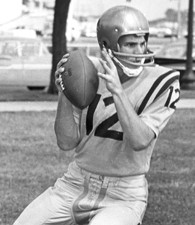Modest, patient and undeniably talented, Roger Staubach took a long route to NFL stardom, but once there he became one of the most accomplished quarterbacks in NFL history.
Roger Staubach’s Early Days
Born February 5, 1942, and raised Cincinnati, Ohio, Roger Staubach was a natural athlete, excelling in football, basketball and baseball. A quarterback with great strength and speed under fire, Staubach attracted the interest of college football powerhouses Ohio State and Notre Dame, but he was drawn to the U.S. Naval Academy. Needing to improve his math test scores, he spent a post-graduate year at a prep school in New Mexico before enrolling at the academy.
Although he got off to a rocky start, Staubach soon found his rhythm in Annapolis and quickly established himself as figure on the national stage while leading Navy to a 9-1 regular season. Though he fell short of a national championship with a Cotton Bowl loss to Texas, Staubach was awarded the Heisman Trophy.
Staubach racked up 4,253 yards in total offense over his three-year college career—a statistic that would earn him a place in the College Football Hall of Fame in 1981.
Though few questioned Staubach’s talent, most NFL teams were hesitant to draft him due to his commitment to the Naval Academy, which required him to serve four years in the armed services after graduation.
The Dallas Cowboys took a chance on him, selecting the then-junior quarterback with their 10th round pick in the 1964 draft knowing that he would not be eligible to play for another five years. Staubach attended training camps in between stints of active duty and tried to stay in shape while serving in posts across the world, including Vietnam.
Sources in this Story
- Encyclopedia.com: Roger Staubach
- ESPN: Game in the Shadows
- Time: Jolly Roger
- Heisman Trust: Roger Staubach
- College Football Hall of Fame: Roger Staubach
- NFL.com: Top All-Time NFL Draft Steals
- Pro Football Hall of Fame: Roger Staubach
- Catholic Online: The Top Ten Catholic Heroes of the Super Bowl
- Famous Texans: Roger Staubach
- Forbes: Roger Staubach’s Draw Play
Staubach’s Pro Career
Staubach was welcomed into the Cowboy camp in 1969 as a 27-year-old NFL rookie. Initially he served as a back-up quarterback, though he was hesitant to complain given his appreciation for the coaching leadership of Tom Landry, a man he would credit for much of his professional success over the years.
Although he earned a starting position at the beginning of the 1972 season, a separated shoulder almost ended his time on top before it began. Late in the season the new starter solidified his position and a reputation for come-from-behind victories when he scored two touchdowns in the final 90 seconds of a divisional playoff against San Francisco.
From then on, Staubach became America’s quarterback, leading his Cowboys to become one of the most successful and popular teams of the 1970s, and earning them the title, America’s Team. He would not relinquish his starting position for the rest of his career.
During his 11-year career with the Cowboys, Staubach earned an impressive 22,700 passing yards and 153 touchdowns, as well as 2,264 yards on his feet and 20 rushing touchdowns. The modest star would lead his team to four Super Bowls during the 1970s, winning two and establishing him as the NFL’s passing leader four times.
Staubach owed many of his victories to his ability to scramble out of tight situations—a skill that reportedly caused a fair deal of good-natured tension between the quarterback and Landry.
Beyond garning impressive stats, Staubach earned a reputation for leadership and courage under pressure for his ability to repeated pull victories from the jaws of certain defeat, totaling 23 come-from-behind, fourth quarter victories.
However, one particular pass in 1975 cemented Staubach’s position in professional football lore forever. Facing the Minnesota Vikings in a playoff game, Staubach launched a seemingly impossible 50-yard pass to Drew Pearson to win the game. Asked afterward what possessed him to take such a gamble, the devoutly Catholic Staubach said that he simply said a quick Hail Mary and threw. His comment would stick, and be used on fields in schoolyards and stadiums to define all last-ditch, final second passes.
The Man and His Work
- “Roger Staubach: Captain America,” by Mike Towle
- “Staubach: Portrait of the Brightest Star,” by Carlton Stowers
- “NFL Films: The Dallas Cowboys—The Complete History”
The Rest of the Story
Retiring in 1979 with the best passing average of any active quarterback up to that point, Staubach was inducted into the Professional Football Hall of Fame in 1985, his first year of eligibility.
Perhaps aware that his late start would limit his time in the NFL, Staubach started venturing outside professional football almost as soon as he arrived in Dallas, working for a commercial real estate company during the off-season.
He started his own company in 1977, and expanded it to include an array of professional advisory services in more than 70 offices worldwide. The company was sold in 2008 for an estimated $613 million.
This article was originally written by Christopher Coats; it was updated December 6, 2016.











